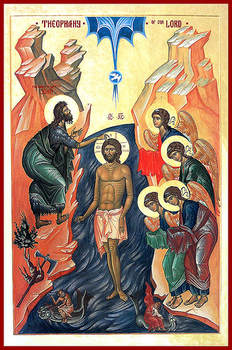20 Brief Facts about the Life and Death of St. John the Baptist
Source: The Catalog of Good Deeds
1. St John the Baptist was born to a childless elderly people whose names were Zachariah and Elisabeth.
2. St John was born into a family of priests and was the ancestor of Aaron from the tribe of Levi.
3. Archangel Gabriel brought the good news about the birth of John to Zachariah during the Divine service and stated also the name of the future prophet. For his unbelief, Zachariah was punished and lost his voice for 9 months and 8 days until the day when he had to announce the name of his child.
4. John the Baptist and Jesus Christ were second cousins on the mother’s side. John was 6 months older than Jesus.
5. They met each other only two times. Their first meeting occurred when they were still in the womb of their mothers. The second time was at the baptism of the Savior.
6. John, as well as Jesus, avoided death in his childhood, when Herod the Great ordered to kill the infants (14 thousands were killed in Bethlehem). However, he would suffer in the future from the hands of the king’s son – Herod Antipas. According to the tradition, Zachariah was murdered in the temple, while Elisabeth escaped with the child to the desert and lived there until she died.
7. Until the age of 30, John lived in the desert of Judea. He wore a tight clothing made of the camel hair, and ate wild honey and dried locusts.
8. John baptized people in the Jordan river in Bethabara (6-7 miles from the Dead Sea). The word Bethabara means “the house of ford”, since in that very place more than a thousand years prior to the baptism of the Lord, the people of Israel had crossed the Jordan river on their way to the Promised Land. In the memory of that miraculous event, they built there a special monument – an altar made of 12 stones.
9. John’s baptism was a symbolic purification and the final stage of repentance after the confession of sins.
10. John is called “the Forerunner” because he began his preaching earlier than Christ did, and was the announcer of His coming to the world.
11. John is called “the Baptist” because his main mission was fulfilled on the day of the Baptism of the Lord. On that very day, St John was honored to see the Holy Trinity.
12. After John’s preaching, a whole group of his disciples appeared and followed him. They were called “the disciples of John” and led an ascetic life. Once John pointed to Christ and said to two of his disciples, “Behold! The Lamb of God who takes away the sin of the world!” (John 1:29) and they followed Him. Those were the future apostles Andrew and John.
13. St John convicted Herod Antipas for his illegal marriage with Herodias, the wife of his own brother Philipp, who was also Herod’s niece. The Forerunner was imprisoned after Christ’s sermon on the mount. He was so popular among the people that the authorities did not dare to execute him for a long time.
14. During his imprisonment, John was visited by his disciples, and even Herod himself would often come to him to have conversations.
15. Being imprisoned for quite a long time, John began to doubt Christ. To strengthen his mind and faith, he sent his disciples to Christ with a question: “Are You the Coming One, or do we look for another?” And he received the answer that assured him: “Blessed is he who is not offended because of Me” (Matthew 11:2-4).
16. As a reward for her dancing at the feast, Salome, the daughter of Herodias, got John’s head on the plate at the behest of her mother. According to the tradition, the cut off head continued convicting the sins of the royal family. Terrified Herodias hit the head with a dagger and stabbed its tongue with pins.
17. St John the Forerunner was executed in AD 32.
18. The head and the right hand of St John survived to our days – these are the first and the most ancient relics. Apostle Luke himself brought the right hand of St John to Antioch.
19. There is a tradition according to which Salome died soon for what she had done to the prophet. Herod and Herodias were terrified when they had learned about the miracles of Christ and thought that it was John who had resurrected somehow. Herod Antipas payed for his sins as well: his army was defeated by the Arabian kind Aretha IV, who was the father of Phaselis, Herod’s enraged lawful wife. Herod did not receive any help from Rome and his territories were lost, while he and Herodias were sent to exile. Soon Herod would get sick and die in pain.
20. John came to this world “in the spirit and power of Elijah” and was the greatest one of all the prophets.



